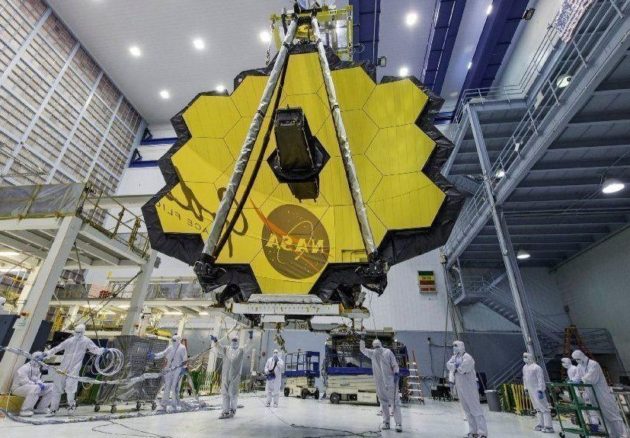
NASA says the launch of its flagship James Webb Space Telescope is being rescheduled for no earlier than 2021, with its total price tag boosted to $9.66 billion.
That price tag includes a development cost of $8.8 billion, which breaks the $8 billion development cost cap mandated by Congress in 2011. That was the last time the Webb project went through a do-or-die debate.
“Congress will have to reauthorize Webb through this next cycle of authorization,” NASA Associate Administrator Steve Jurczyk said today during a teleconference announcing the reset.
NASA officials strongly supported going ahead with the telescope, which is in the latter stages of testing and assembly. The general-purpose telescope is expected to build on the trailblazing observations of the Hubble Space Telescope and provide unprecedented insights about exoplanets and the farthest frontiers of the observable universe.
“Webb is worth the wait,” said Thomas Zurbuchen, associate administrator for NASA’s Science Mission Directorate.
That sentiment was seconded by NASA Administrator Jim Bridenstine in a statement.
“Webb is a top-priority mission that has great national importance for the agency and it will move forward,” Bridenstine said. “Webb will leave a legacy of exceptional science and cutting-edge technical innovations in the years ahead and will inspire future generations of astronomers, explorers, scientists, artists and engineers.”
Over the past year, the schedule for Webb’s launch on a European Space Agency Ariane 5 rocket has been reset from 2018 to 2019 to 2020, and now to no earlier than March 30, 2021. The longer wait and higher cost are in line with an assessment by an independent review board, headed by veteran aerospace executive Tom Young.
Young confirmed that the cost of delays was building up at about $1 million a day. His board’s report traced the snags to five factors, ranging from human errors and problems embedded in the assembly process to lack of experience, systems complexity and excessive optimism.
The previously documented human errors include the use of a solvent that ruined some of the valves on the telescope’s thruster system, improper installation of fasteners for the cover of the telescope’s sunshield cover, and a heater test that was conducted at the wrong voltage.
Young said the mistakes could have been avoided with “simple fixes that were not implemented,” but ended up costing the project $600 million.
The independent panel’s report laid out 32 steps to amend the project’s failings by bringing in more oversight and more quality control.
“We fully agree with 30 of those,” Zurbuchen said. Two of the recommendations focus on more complex issues and require additional review, but “we fully agree with the intent,” he said.
The James Webb Space Telescope project is significantly more complex than Hubble because it’s designed to make observations from a gravitational balance point a million miles from Earth, with no scenario for servicing.
The supercooled telescope will require a sunshield that’s folded up origami-style for launch and has to unfold unfailingly in space. Young said there was “no significant legacy” for such a system, which adds to the mission risk.
“Mission success is the top priority,” he said.
The new price tag of $9.66 billion includes costs for integration and testing of the telescope, as well as funding for the first five years of operation.
NASA officials and scientists vowed to keep the project on track for 2021, even as they voiced annoyance and frustration over past delays.
“Make no mistake,” Zurbuchen said. “I’m not happy sitting here having to share this story. We never want to do this. We always want to talk about the successes that we have.”



